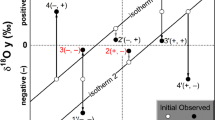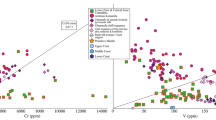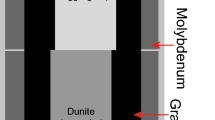Abstract—
Knowledge of mineral–melt partition coefficients (D) is necessary for geochemical modeling of magma formation and evolution. The main source of these parameters is experiments on equilibrium between minerals and silicate melt. The database on mineral–melt equilibrium experiments has grown continuously, which allows one to refine partition coefficients and reveal the most important factors affecting them. This paper reports the analysis of available experimental data on trace element partitioning between olivine and melt (7000 experiments from 587 publications were used). Based on the statistical processing of the data array, the dependence of D on melt and olivine composition and P–T conditions was evaluated. It was found that most of incompatible elements are either insensitive or moderately sensitive to these parameters. Among the compositional parameters, CaO content in melt is most significant. It was shown that D estimates can be significantly improved by using ratios of D values for different elements. Such ratios are often independent of experimental parameters and much less variable than D values for particular elements. The obtained D estimates for basaltic compositions vary within six orders of magnitude, from <10–5 (U, Th, and La) to ~5–10 (Co and Ni). The low D values for most elements (<0.1) indicate that many trace element ratios in melts do not change significantly even at high degrees of olivine crystallization. The obtained estimates were compared with data on element partitioning between high-pressure (Mg,Fe)2SiO4 phases (wadsleyite and ringwoodite) and silicate melt and between olivine and carbonate–silicate melts. In both cases, there is a close similarity to element partitioning between olivine and silicate melt. One exception is REE. DREE values for the wadsleyite/ringwoodite–melt and olivine–carbonate melt systems are approximately one order of magnitude lower than those for olivine–silicate melt partitioning.









Similar content being viewed by others
REFERENCES
N. L. Allan, Z. Du, M. Y. Lavrentiev, J. D. Blundy, J. A. Purton, and W. van Westrenen, “Atomistic simulation of mineral–melt trace-element partitioning,” Phys. Earth Planet. Int. 139, 93–111 (2003).
M. Bau, “Controls on the fractionation of isovalent trace elements in magmatic and aqueous systems: evidence from Y/Ho, Zr/Hf, and lanthanide tetrad effect,” Contrib. Mineral. Petrol. 123, 323–333 (1996).
P. Beattie, “On the occurrence of apparent non-Henry’s Law behaviour in experimental partitioning studies,”Geochim. Cosmochim Acta. 57, 47–55 (1993).
P. Beattie, “Systematics and energetics of trace-element partitioning between olivine and silicate melts: implications for the nature of mineral/melt partitioning,” Chem. Geol. 117, 57–71 (1994).
P. Beattie, C. Ford, and D. Russell, “Partition coefficients for olivine-melt and orthopyroxene-melt systems,” Contrib. Mineral. Petrol. 109, 212–224 (1991).
J. H. Bedard, “Partitioning coefficients between olivine and silicate melts,” Lithos 83, 394–419 (2005).
J. Blundy and J. Dalton, “Experimental comparison of trace element partitioning between clinopyroxene and melt in carbonate and silicate systems, and implications for mantle metasomatism,” Contrib. Mineral. Petrol. 139, 356–371 (2000).
J. Blundy and B. Wood, “Partitioning of trace elements between crystals and melts,” Earth Planet. Sci. Lett. 210, 383–397 (2003).
J. D. Blundy and B. J. Wood, “Prediction of crystal–melt partition coefficients from elastic moduli,” Nature 372, 452–454 (1994).
A. Borisov, A. Pack, A. Kropf, and H. Palme, “Partitioning of Na between olivine and melt: An experimental study with application to the formation of meteoritic Na2O-rich chondrule glass and refractory forsterite grains,” Geochim. Cosmochim. Acta. 72, 5558–5573 (2008).
D. Canil, “Vanadium partitioning and the oxidation state of Archean komatiite magmas,” Nature 389, 842–845 (1997).
D. Canil and Y. Fedortchouk, “Olivine–liquid partitioning of vanadium and other trace elements, with applications to modern and ancient picrites,” Can. Mineral. 39, 319–330 (2001).
R. O. Colson, G. A. Mckay, and L. A. Taylor, “Temperature and composition dependencies of trace element partitioning: Olivine/melt and low-Ca pyroxene/melt,” Geochim. Cosmochim. Acta. 52, 539–553 (1988).
P. Condamine, S. Couzinie, A. Fabbrizio, J.-L. Devidal, and E. Medard, “Trace element partitioning during incipient melting of phlogopite-peridotite in the spinel and garnet stability fields,” Geochim. Cosmochim. Acta 327, 53–78 (2022).
Stefano F. Di, S. Mollo, J. Blundy, P. Scarlato, M. Nazzari, and O. Bachmann, “The effect of CaO on the partitioning behavior of REE, Y and Sc between olivine and melt: Implications for basalt–carbonate interaction processes,” Lithos 326–327, 327–340 (2019).
C. Dupuy, J. M. Liotard, and J. Dostal, “Zr/Hf fractionation in intraplate basaltic rocks: carbonate metasomatism in the mantle source,” Geochim. Cosmochim. Acta 56, 2417–2423 (1992).
M. Ya. Frenkel, A. A. Yaroshevskii, A. A. Ariskin, G. S. Barmina, E. V. Koptev-Dvornikov, and B. S. Kireev, Dynamics of Intrachamber Differentiation of Basaltic Magmas (Nauka, Moscow, 1988) [in Russian].
A. V. Girnis, V. K. Bulatov, G. P. Brey, A. Gerdes, and H. E. Höfer, “Trace element partitioning between mantle minerals and silico-carbonate melts at 6–12 GPa and applications to mantle metasomatism and kimberlite genesis,” Lithos 160–161, 183–200 (2013).
D. H. Green and M. E. Wallace, “Mantle metasomatism by ephemeral carbonatite melts,” Nature 336, 459–462 (1988).
T. H. Green, “Experimental studies of trace-element partitioning applicable to igneous petrogenesis–Sedona 16 years later,” Chem. Geol. 117, 1–36 (1994).
J. Guo and T. H. Green, “Barium partitioning between alkali feldspar and silicate liquid at high temperature and pressure,” Contrib. Mineral. Petrol. 102, 328–335 (1989).
B. Hanson and J. H. Jones, “The systematics of Cr3+ and Cr2+ partitioning between olivine and liquid in the presence of spinel,” Am. Mineral. 83, 669–684 (1998).
W. J. Harrison, “Partition coefficients for REE between garnets and liquids: implications of non-Henry’s law behaviour for models of basalt origin and evolution,” Geochim. Cosmochim Acta 45, 1529–1544 (1981).
W. J. Harrison and B. J. Wood, “An Experimental investigation of the partitioning of REE between garnet and liquid with reference to the role of defect equilibria,” Contrib. Mineral. Petrol. 72, 145–155 (1980).
I. Horn, S. F. Foley, S. E. Jackson, and G. A. Jenner, “Experimentally determined partitioning of high field strength- and selected transition elements between spinel and basaltic melt,” Chem. Geol. 117, 193–218 (1994).
W. Irber, “The lanthanide tetrad effect and its correlation with K/Rb, Eu/Eu*, Sr/Eu, Y/Ho, and Zr/Hf of evolving peraluminous granite suites,” Geochim. Cosmochim. Acta 63, 489–508 (1999).
A. J. Irving, “A review of experimental studies of crystal/liquid trace element partitioning,” Geochim. Cosmochim. Acta 42, 743–770 (1978).
M. H. G. Jacobs, R. Schmid-Fetzer, and A. P. van den Berg, “Thermophysical properties and phase diagrams in the system MgO–SiO2–FeO at upper mantle and transition zone conditions derived from a multiple-Einstein method,” Phys. Chem. Minerals 46, 513–534 (2019).
J. H. Jones, “Temperature- and pressure-independent correlations of olivine-liquid partition coefficients and their application to trace element partitioning,” Contrib. Mineral. Petrol. 88, 126–132 (1984).
H. Kagi, Y. Dohmoto, S. Takano, and A. Masuda, “Tetrad effect in lanthanide partitioning between calcium sulfate crystal and its saturated solution. Chem. Geol. 107, 71–82 (1993).
M. J. Le Bas, R. N. Le Maitre, A. Streckeisen, and B. Zanettin, “A Chemical Classification of Volcanic Rock Based on Total Silica Diagram,” J. Petrol. 27, 745–750 (1986).
C. Li and E. M. Ripley, “The relative effects of composition and temperature on olivine-liquid Ni partitioning: Statistical deconvolution and implications for petrologic modeling,” Chem. Geol. 275, 99–104 (2010).
G. Mallmann and H. St.C. O’Neill, “Calibration of an empirical thermometer and oxybarometer based on the partitioning of Sc, Y and V between olivine and silicate melt,” J. Petrol. 54, 933–949 (2013).
A. Masuda, O. Kawakami, Y. Dohmoto, and T. Takenaka, “Lanthanide tetrad effects in nature: Two mutually opposite types, W and M,” Geochem. J. 21, 119–124 (1987).
K. Mibe, Y. Orihashi, S. Nakai, and T. Fujii, “Element partitioning between transition–zone minerals and ultramafic melt under hydrous conditions,” Geophys. Res. Lett. 33, L16307.https://doi.org/10.1029/2006GL026999
A. Navrotsky, “Thermodynamics of element partitioning: (1) Systematics of transition metals in crystalline and molten silicates and (2) defect chemistry and the Henry’s law problem,” Geochim. Cosmochim. Acta 42, 887–902 (1978).
R. L. Nielsen, “A model for the simulation of combined major and trace element liquid lines of decent,” Geochim. Cosmochim. Acta 52, 27–38 (1988).
R. L. Nielsen, “BIGD.FOR: A Fortran program to calculate trace-element partition coefficients for natural mafic and intermediate composition magmas,” Comp. Geosci. 18, 773–788 (1992).
S. Prowatke and S. Klemme, “Rare earth element partitioning between titanite and silicate melts: Henry’s law revisited,” Geochim. Cosmochim. Acta 70, 4997–5012 (2006).
P. L. Roeder and R. F. Emslie, “Olivine–liquid equilibrium,” Contrib. Mineral. Petrol. 29, 275–289 (1970).
R. L. Rudnick, W. F. McDonough, and B. W. Chappell, “Carbonatite metasomatism in the northern Tanzanian mantle: petrographic and geochemical characteristics,” Earth Planet. Sci. Lett. 114, 463–475 (1993).
I. V. Veksler, A. M. Dorfman, M. Kamenetsky, P. Dulski, and D. B. Dingwell, “Partitioning of lanthanides and Y between immiscible silicate and fluoride melts, fluorite and cryolite and the origin of the lanthanide tetrad effect in igneous rocks. Geochim. Cosmochim. Acta 69, 2847–2860 (2005).
B. J. Wood and J. D. Blundy, “Trace element partitioning: The influences of ionic radius, cation charge, pressure, and temperature,” Treatise on Geochemistry 3, 421–448 (2014).
A. B. Woodland, V. K. Bulatov, G. P. Brey, A. V. Girnis, H. E. Höfer, and A. Gerdes, “Subduction factory in an ampoule: Experiments on sediment–peridotite interaction under temperature gradient conditions,” Geochim. Cosmochim. Acta 223, 319–349 (2018).
G. M. Yaxley, A. J. Crawford, and D. H. Green, “Evidence for carbonatite metasomatism in spinel peridotite xenoliths from western Victoria, Australia,” Earth Planet. Sci. Lett. 107, 305–317 (1991).
ACKNOWLEDGMENTS
The author thanks A.A. Ariskin (Moscow State University) and G.S. Nikolaev (Vernadsky Institute of Geochemistry and Analytical Chemistry, Russian Academy of Sciences) for attentive analysis of the manuscript and valuable comments and recommendations.
Funding
This study was carried out under government-financed research project FMMN-2021-0003 for the Institute of Geology of Ore Deposits, Petrography, Mineralogy, and Geochemistry, Russian Academy of Sciences.
Author information
Authors and Affiliations
Corresponding author
Ethics declarations
The author declares that he has no conflicts of interest.
Additional information
Translated by E. Kurdyukov
Supplementary Information
Rights and permissions
About this article
Cite this article
Girnis, A.V. Trace Element Partitioning between Olivine and Melt: Analysis of Experimental Data. Geochem. Int. 61, 311–323 (2023). https://doi.org/10.1134/S0016702923040055
Received:
Revised:
Accepted:
Published:
Issue Date:
DOI: https://doi.org/10.1134/S0016702923040055




